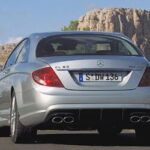My work commitments recently demanded several trips back and forth from San Francisco to Napa over three days. This unexpected routine gave me ample opportunity to truly understand the 2013 Mercedes-benz C 250. There are a few key aspects of this car that became increasingly clear and appreciable during those drives.
Firstly, the seating, driving position, and responsiveness of the controls are remarkably efficient and conducive to relaxed driving. While subtly present, I could sense a faint echo of the robust, forged-steel character of my old 190E, a lineage subtly maintained in its modern descendant, even if slightly softened by contemporary sound-deadening requirements. Having just spent time in a Passat and a CC, both of which were surprisingly close in price to this Mercedes, returning to the C250’s understated black-vinyl-and-aluminum interior was a welcome relief.
Secondly, the features that the car does include operate exceptionally well. The Bluetooth integration is seamless, and hands-free calls are delivered with impressive clarity. The climate control system effectively managed both hot and cold conditions without introducing excessive fan noise into the quiet cabin. The cruise control stands out with its intuitive design: a gentle nudge adjusts the speed by one mile per hour, while a more deliberate push shifts it to the nearest five mph increment. Transitioning from a 50mph zone to 65mph? Three quick taps and you’re effortlessly keeping pace. A dedicated Mercedes-Benz enthusiast might wax lyrical about the company’s knack for engineering vehicles for stress-free, high-speed cruising, and while that’s a valid point, it’s easy to get carried away. Let’s just say the C250 prioritizes functional excellence over flashy gadgets.
The 2013 C250 is a car that subtly wins you over. A brief encounter at an auto show is unlikely to leave a lasting impression. Similarly, a short twenty-minute test drive might not fully reveal its merits, potentially leading you to consider alternatives. Respect for this car is earned over time. This isn’t about growing accustomed to shortcomings; rather, it’s about developing a genuine fondness for its inherent strengths and well-considered virtues.
During a sustained drive of nearly three hundred miles, often in stop-and-go traffic, frequently tapping into the 201 “pseudo-electric ponies,” the small Mercedes-Benz surprisingly averaged 28.9 miles per gallon. While respectable, I decided to push its limits. With a spontaneous urge to visit the coast, I programmed a route from Napa to Stinson Beach, continuing to the Golden Gate Bridge overlook. I even brought along a passenger, anticipating a bit of amusement from their reactions. Along the coastal roads, we pushed the small four-cylinder engine to its maximum, aggressively engaging the ABS as hairpin turns approached. Exiting corners, I’d let the rear end drift wide, sending gravel tumbling down the steep cliffs towards the ocean. Overtaking maneuvers were executed whenever the slightest opportunity arose. As the miles accumulated, I found myself repeatedly testing the limits. At one point, as the C250 shifted into fourth gear on an uphill right-hander, with only the sea and horizon visible ahead, I emphatically stomped the floor twice, audibly declaring “NO BRAKES!” before relying on the anti-lock system to squeal us around the blind corner and onto the next straight – a maneuver that, admittedly, was not met with enthusiasm by my passenger.
Reaching the Golden Gate Bridge overlook provided a moment for reflection and a solidifying of my opinion on the C250. Here it is: Certainly, there are other vehicles in the same price bracket that offer a longer list of features, more horsepower, greater interior space, or enhanced convenience. You might very well be inclined to choose one of those. This isn’t a W126 built for a million miles, and expecting unparalleled longevity or durability from a modern Mercedes-Benz is perhaps outdated. However, what you gain with the C250, in exchange for forgoing navigation systems, leather upholstery, and expansive rear seating, is a car built on a fundamentally sound and no-excuses chassis. It delivers a distinctly more satisfying driving experience compared to mainstream sedans like a Camry, Passat, or Fusion. On demanding roads, the performance gap between the C250 and those front-wheel-drive competitors becomes substantial.
That unassuming, turbocharged four-cylinder engine, despite my less-than-responsible driving, still managed to return 22 miles per gallon on that spirited coastal drive. Under similar conditions, my own Boxster would likely consume twice as much fuel. While the 1.8-liter turbo isn’t going to win any awards for auditory pleasure, the fuel economy is undeniably impressive. Naturally, opting for the more potent V-6 in the C350 would be tempting, and undoubtedly welcomed by Mercedes-Benz. Yet, the 1.8-liter is perfectly adequate. No one will eagerly anticipate hearing it rev, but the same could be said of the diesel engine in the classic 240D.
In conclusion, the 2013 Mercedes-Benz C 250 is relatively affordable within its class, doesn’t overwhelm with superfluous features, and while the engine is unremarkable, the underlying chassis is robust and dependable over extended use. For many, that aligns perfectly with the core expectations of a Mercedes-Benz. If any contemporary car deserves to carry the iconic three-pointed star, the C250 makes a strong case for itself as an embodiment of understated, yet genuine, Mercedes-Benz values.
